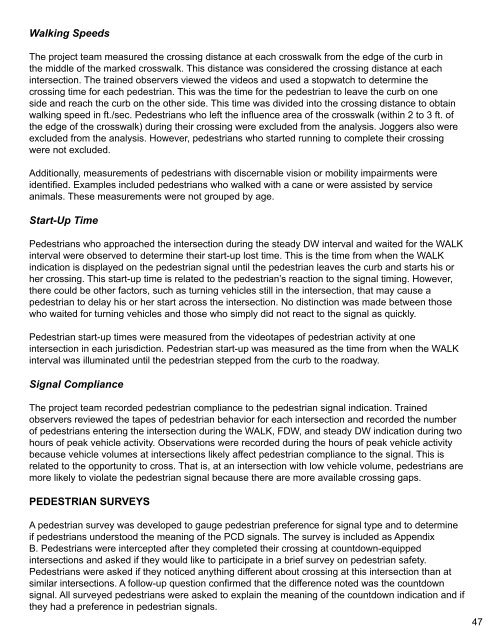Pedestrian Signal Safety - AAA Foundation for Traffic Safety
Pedestrian Signal Safety - AAA Foundation for Traffic Safety
Pedestrian Signal Safety - AAA Foundation for Traffic Safety
You also want an ePaper? Increase the reach of your titles
YUMPU automatically turns print PDFs into web optimized ePapers that Google loves.
Walking Speeds<br />
The project team measured the crossing distance at each crosswalk from the edge of the curb in<br />
the middle of the marked crosswalk. This distance was considered the crossing distance at each<br />
intersection. The trained observers viewed the videos and used a stopwatch to determine the<br />
crossing time <strong>for</strong> each pedestrian. This was the time <strong>for</strong> the pedestrian to leave the curb on one<br />
side and reach the curb on the other side. This time was divided into the crossing distance to obtain<br />
walking speed in ft./sec. <strong>Pedestrian</strong>s who left the influence area of the crosswalk (within 2 to 3 ft. of<br />
the edge of the crosswalk) during their crossing were excluded from the analysis. Joggers also were<br />
excluded from the analysis. However, pedestrians who started running to complete their crossing<br />
were not excluded.<br />
Additionally, measurements of pedestrians with discernable vision or mobility impairments were<br />
identified. Examples included pedestrians who walked with a cane or were assisted by service<br />
animals. These measurements were not grouped by age.<br />
Start-Up Time<br />
<strong>Pedestrian</strong>s who approached the intersection during the steady DW interval and waited <strong>for</strong> the WALK<br />
interval were observed to determine their start-up lost time. This is the time from when the WALK<br />
indication is displayed on the pedestrian signal until the pedestrian leaves the curb and starts his or<br />
her crossing. This start-up time is related to the pedestrian’s reaction to the signal timing. However,<br />
there could be other factors, such as turning vehicles still in the intersection, that may cause a<br />
pedestrian to delay his or her start across the intersection. No distinction was made between those<br />
who waited <strong>for</strong> turning vehicles and those who simply did not react to the signal as quickly.<br />
<strong>Pedestrian</strong> start-up times were measured from the videotapes of pedestrian activity at one<br />
intersection in each jurisdiction. <strong>Pedestrian</strong> start-up was measured as the time from when the WALK<br />
interval was illuminated until the pedestrian stepped from the curb to the roadway.<br />
<strong>Signal</strong> Compliance<br />
The project team recorded pedestrian compliance to the pedestrian signal indication. Trained<br />
observers reviewed the tapes of pedestrian behavior <strong>for</strong> each intersection and recorded the number<br />
of pedestrians entering the intersection during the WALK, FDW, and steady DW indication during two<br />
hours of peak vehicle activity. Observations were recorded during the hours of peak vehicle activity<br />
because vehicle volumes at intersections likely affect pedestrian compliance to the signal. This is<br />
related to the opportunity to cross. That is, at an intersection with low vehicle volume, pedestrians are<br />
more likely to violate the pedestrian signal because there are more available crossing gaps.<br />
PEDESTRIAN SURVEYS<br />
A pedestrian survey was developed to gauge pedestrian preference <strong>for</strong> signal type and to determine<br />
if pedestrians understood the meaning of the PCD signals. The survey is included as Appendix<br />
B. <strong>Pedestrian</strong>s were intercepted after they completed their crossing at countdown-equipped<br />
intersections and asked if they would like to participate in a brief survey on pedestrian safety.<br />
<strong>Pedestrian</strong>s were asked if they noticed anything different about crossing at this intersection than at<br />
similar intersections. A follow-up question confirmed that the difference noted was the countdown<br />
signal. All surveyed pedestrians were asked to explain the meaning of the countdown indication and if<br />
they had a preference in pedestrian signals.<br />
47








